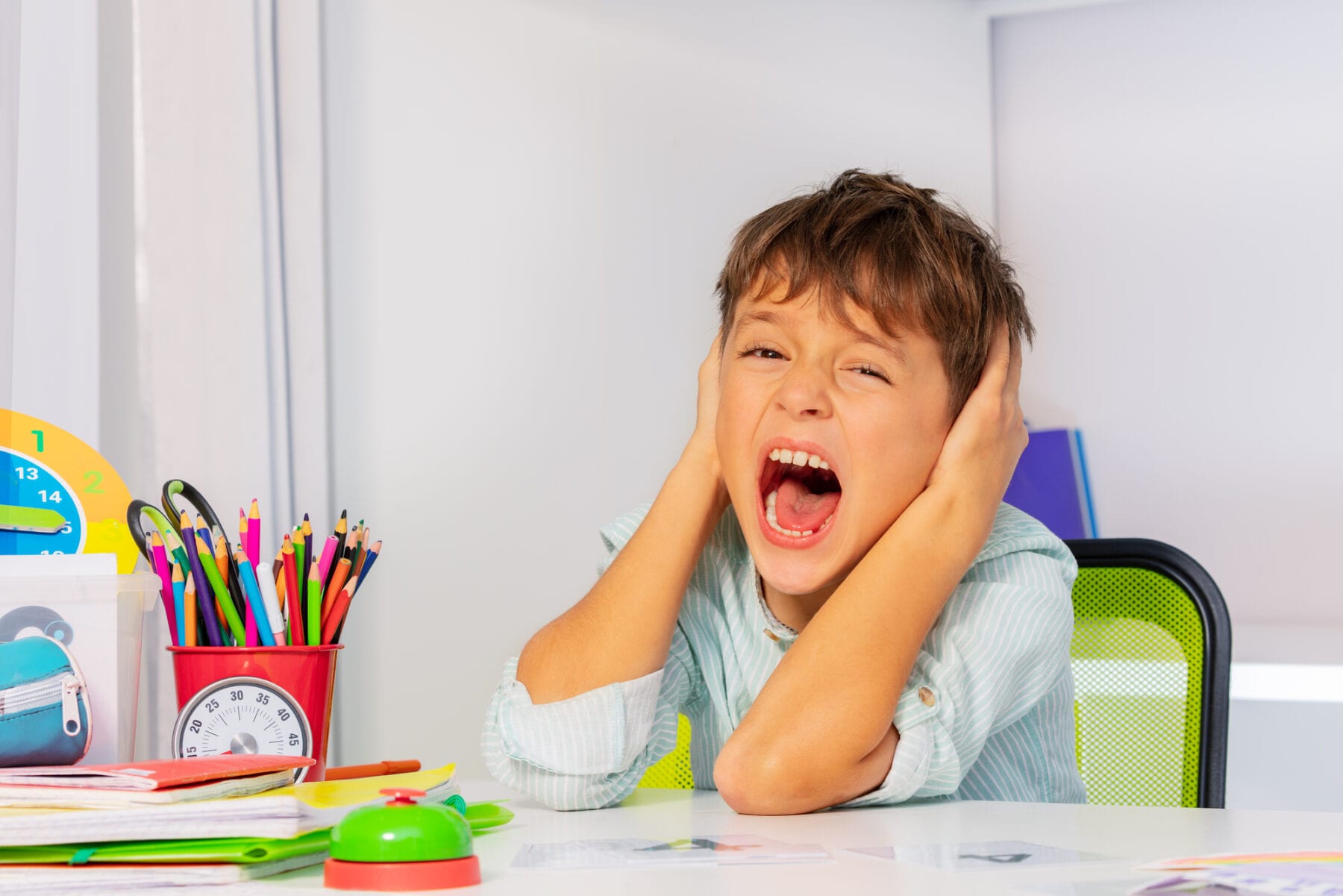Controlling angry feelings is a challenge for children with autism.
With some patience and understanding, however, your child can learn to successfully deal with their anger.
Here’s everything you need to know about the typical anger issues that children with autism face and how ABA therapy can help them regulate their emotions.
But first, let’s get a better understanding of the common traits that children with autism have.
The common challenges autistic children face
Sensory issues
Most children with autism spectrum disorder are affected by sensory overload that occurs when there is more input from the five senses than the brain can process. Noise, crowds, bright lights, strong tastes, and smells may also feel disruptive and stressful to children with autism.
Social difficulties
One of the main challenges that autistic children have to deal with is social interactions. They may have a hard time deciphering social cues and body language when interacting with others and difficulties developing deep social relationships.
Resistance to change
Children with autism are often resistant to changes and prefer familiar situations and activities. Any disruption in their routines could cause a disproportionate outburst of anger or frustration.
Emotional sensitivity
Autistic children frequently struggle to control their emotions in unpredictable situations and when transitioning from one activity or setting to the next. Children with autism display unusually intense emotional reactions in these situations compared to their neurotypical peers.
Communication challenges
Children with autism typically have a good understanding of language and can develop an impressive vocabulary. At the same time, they often struggle with social language skills, that is, the way language is used to communicate with others. They may be unable to grasp sarcasm, idioms, and other expressions that aren’t meant to be taken literally. Some may find conversations with others boring or difficult to follow and avoid speaking with their peers.
Anxiety and depression
Mood disorders such as anxiety, depression, and irritability are common among children with autism. Studies show that 40% of young people with ASD suffer from high levels of anxiety or at least one anxiety disorder, frequently resulting from their lack of social communication skills.
Now that we have a better understanding of the challenges that autistic children face, let’s examine how this can affects their anger levels.
Autistic Children and Their Struggle With Anger
Anger is a common occurrence in autistic children. They often engage in repetitive thinking that, when combined with angry thoughts, can turn into anger ruminations. The frustration experienced by reliving upsetting moments and not being able to express emotions in the way others can understand can lead to outbursts or irritability and anger.
Children with autism who struggle with social and communication issues, as well as those who engage more frequently in repetitive behaviors, are also more likely to have problems with impulse control and emotional regulation. Additional factors such as illness, lack of sleep, and anxiety can also affect their ability to control their anger.
Meltdowns and aggression are common signs of impulse control issues among high-functioning autistic children. As many as one out of every four children across the spectrum display aggressive behaviors. The immediate reaction that children with autism provoke when acting out in an aggressive manner allows them to feel at least some degree of control of the situation.
Autism and the rage cycle
Blind range is the ultimate manifestation of anger and a frequent occurrence in autistic children. The cycle of rage typically consists of three stages: rumbling, rage, and recovery.
Rumbling stage
Autistic meltdowns are usually preceded by signs of distress called rumblings. They include:
- Rocking or pacing
- Placing hands over ears
- Being very still and tense
- Asking lots of questions
- Threatening others.
If a child doesn’t know how to prevent the build-up of anger, he or she will quickly lose control of the situation. At this point, a meltdown is inevitable.
Rage stage
At this stage, anger either culminates into aggression toward caregivers or peers or is internalized. The child may:
- Have a meltdown with crying and shouting.
- Try to run away from the situation, potentially putting him/herself in danger.
- Exhibit aggressive behaviors including hitting, kicking, scratching, and biting.
- Become too upset to listen to calming suggestions.
- Be unable to process instructions given to help them to calm down.
- Overreact to the situation and be unable to calm down on their own.
- Engage in self-harm, including head banging and hair pulling.
- Display self-stimulatory behaviors or “stimming,” such as hand flapping and clapping.
Recovery stage
Following a meltdown, many autistic children will have contrite feelings or won’t remember what happened during the rage stage. Some children will withdraw after the episode or become so physically exhausted that they need to sleep.
It’s important to keep in mind that the anger related to autism is for the most part impulsive. While temper tantrums in neurotypical children are often manipulative, autistic meltdowns are driven by anger without any rational thinking or reasoning behind it. A child reacts in the moment and the behavior is not thought out ahead of time. An angry outburst in an autistic child is usually a cry of distress.
Causes of anger in autistic children
Although each case of autism is different, there are several common causes of anger in autistic children:
Being overwhelmed by multiple tasks
Anyone with autism, including autistic children, can get easily overwhelmed and frustrated when asked to perform several tasks at the same time. This is particularly the case when a new task is combined with the routine one and when tasks need prioritizing.
Sensory overload
Children with autism have fragile sensory systems that can easily get overloaded. Responding with anger outbursts and aggressive behaviors is sometimes simply an automatic reaction to being physically uncomfortable in situations that cause sensory overload.
Feeling helpless
All the unwritten rules and unpredictability’s of daily life may be hard to navigate for autistic children, regardless of their level of functioning. They don’t always fully understand what is going on around them and act out aggressively out of frustration.
Changes in routine
Children on the autism spectrum can become distressed when their routines are changed. Unexpected events like having to take a different route to school or eat a different type of breakfast cereal can increase the child’s anxiety levels. The feelings of confusion and helplessness may cause a meltdown.
Other people’s behavior
Children struggling with autism may take great offense to insensitive comments that their neurotypical peers would judge as harmless humor. Being ignored, whether on purpose or by accident, is another possible trigger for angry outbursts.
Intolerance of imperfections in others
Anger-related behavior in autistic children can be caused indirectly by other people and their perceived imperfections, such as a high-pitched voice or fast speaking pace, for example.
Stress and anxiety
All the elements listed above can potentially lead to built-up stress and anxiety in autistic children. Whereas some will react by becoming depressed, others will get angry. If they have no tools which can help them manage stress and anxiety, they will experience meltdowns.
Lastly, a number of underlying issues such as medical conditions or sleep problems can trigger anger and aggressive outbursts in autistic children.
ABA Therapy for Controlling Anger
Anger treatment is a crucial part of helping your child with autism. Children who haven’t learned how to manage their anger can have a hard time processing their emotions and dealing with built-up stress. The earlier you start with the treatment, the quicker your child will learn and be able to put in use coping and anger management skills.
Applied Behavioral Analysis (ABA) is considered being one of the most successful interventions for helping children with autism learn desired behaviors through positive reinforcement. By improving communication and social skills and regulating potentially harmful behaviors, ABA therapy can help to reduce aggressive actions and help children with high-functioning autism better regulate their emotions, including anger. This type of therapy has been proven to be effective in both reducing and eliminating aggressive behaviors.
When it comes to anger management skills, ABA can help autistic children to:
- Learn how to avoid negative responses or behaviors.
- Reduce the frequency of unwanted behavior.
- Learn acceptable alternative behaviors.
- Identify and appropriately communicate emotions, including anger.
- Learn the coping skills for emotional regulation.
- Have appropriate social interactions and communication that don’t result in aggression.
ABA techniques for dealing with anger
ABA therapy is a highly adaptable and flexible intervention that can be used in a variety of settings and tailored for the specific needs of your autistic child. A therapist will start by spending some time with your child to analyze the behavioral patterns and determine his/her specific strengths and challenges. This functional behavior assessment will represent the basis for the work your child will do in therapy.
The ABA therapist will use a range of techniques to help your child with anger management. ABA therapy offers two effective ways of handling problem behaviors: proactive interventions and consequence-based reactive interventions. When used in combination, these two tactics will give you and your child all the necessary tools for preventing and managing anger issues.
Proactive intervention
Anger triggers are prevalent in an autistic child’s surroundings. That’s why it’s extremely important to use proactive strategies that will help prevent your child from becoming overwhelmed and frustrated. Strategies to minimize anger and aggression triggers include creating an environment that is calm, predictable, and as rewarding as possible for your autistic child.
Positive feedback
Because direct feedback after an aggressive outburst can further reinforce the undesired behavior, your child’s ABA therapist will provide positive feedback for impulse control. Positive feedback to reward non-aggressive behaviors works best if it’s given during stressful moments that can potentially cause angry outbursts. The therapists will offer praise right before the outburst occurs in order to help the child display a more appropriate, non-aggressive behavior.
Neutral redirection
Neutral redirection is a technique regularly used by ABA therapists to teach children with autism how to improve their impulse control. Instead of responding to anger and aggressive behavior with punishment, they redirect the child to use socially acceptable behavior to express their needs. The goal of neutral redirection is to reward the desired non-impulsive and non-aggressive behaviors.
Positive reinforcement
ABA therapy is based on the principle of positive reinforcement. The desired behavior is strengthened by providing a reinforcer such as a favorite toy, activity, or simply attention and praise. Encouraging your child’s appropriate behavior will motivate them to keep behaving well.
Alternative behaviors
ABA therapists help autistic children not only to identify negative responses and unwanted behaviors, but also to learn appropriate alternatives. What’s more, by learning effective and positive ways to communicate their emotions, children will be able to express the anger they would otherwise ruminate over. This way, they can avoid the frustration resulting from an inability to describe their emotions.
Modeling techniques
Modeling techniques are frequently used as part of ABA therapy sessions to encourage children with autism to copy and adopt positive behavior. For example, your child might imitate characters in a video, replicate peer behavior in a small group, or follow the therapist’s model behavior in a one-on-one session.





